Barbfish
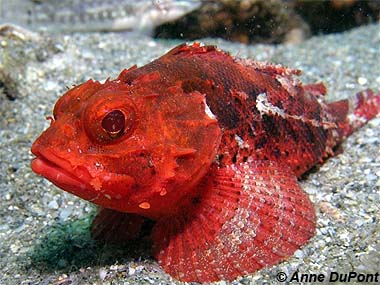
Scorpaena brasiliensis
These venomous bottom-dwellers are excellent at camouflage, sneaking up on invertebrates or small fish, and sucking them down in one swift gulp. They are mottled reds, yellows, and blues, with textured protrusions all over, as well as venomous spines in their dorsal, pelvic and anal fins. From short snout and large, round eyes, to rounded caudal (tail) fin, they usually grow to between eight and 14 inches. Because of their venomous spines, they should be handled with care, if at all.
Order – Scorpaeniformes
Family – Scorpaenidae
Genus – Scorpaena
Species – brasiliensis
Common Names
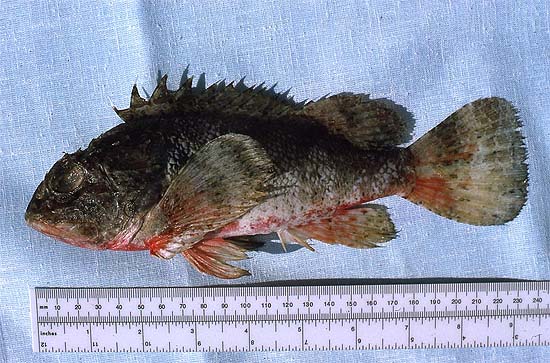
English language common names are barbfish, goosehead scorpionfish, orange scorpionfish, and red barbfish. Other language common names include arracacho (Spanish), beatinha (Portuguese), beatriz (Portuguese), brasiliansk skægfisk (Danish), buraziru-fusakasago (Japanese), escorpión pardo (Spanish), mamangá (Portugese), niquim (Portuguese), niquim da-pedra (Portuguese), niquim de-pedra (Portuguese), peixe escorpião (Portuguese), peixe pedra (Portuguese), rascacio (Spanish), rascacio chasnete (Spanish), rascacio chasnete ojo (Spanish), rascacio pardo (Spanish), rascasio (Spanish), rascasse brésilienne (French), and sapo chaznete rojo (Spanish).
Importance to Humans
The barbfish is considered venomous to humans and should be handled with care. The venom is located along the spines in the dorsal, pelvic, and anal fins. There have been reported cases of injuries resulting from barbfish-human interactions. This species is also often seen displayed in aquariums if there are plenty of hiding spaces and appropriate food items.
Conservation
The barbfish is not listed as endangered or vulnerable with the World Conservation Union (IUCN). The IUCN is a global union of states, governmental agencies, and non-governmental organizations in a partnership that assesses the conservation status of species.
> Check the status of the barbfish at the IUCN website.
Geographical Distribution
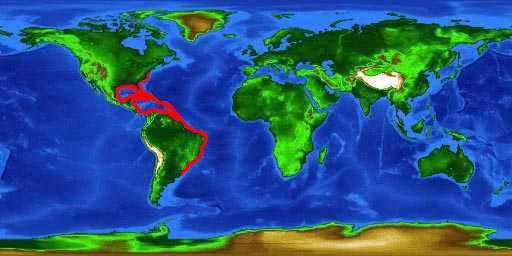
The barbfish is found in the western Atlantic Ocean from Virginia (US) to the northern Gulf of Mexico including the Greater and Lesser Antilles, south to Brazil. This species is common in the northern Gulf of Mexico. It was formally reported in the waters off Bermuda, it has not been collected or observed there since 1927.
Habitat
This member of the family Scorpaenidae is commonly found residing over soft bottom and coral reef habitats from the shoreline to depths of 330 feet (100 m) in bays, harbor and on the continental shelf. Scorpionfish are generally solitary except during courtship and spawning.
Biology
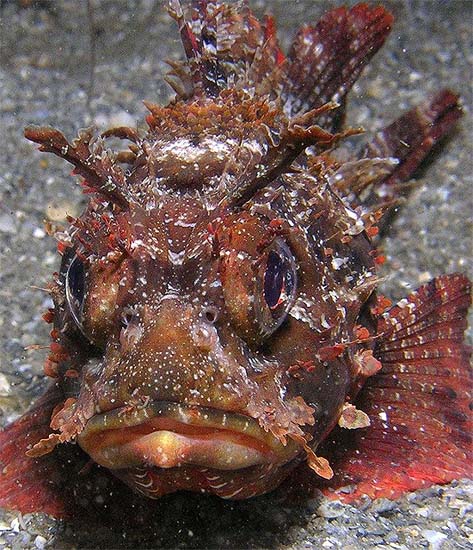
Distinctive Features
The head and the snout of the barbfish are moderately short. The occipital pit is well developed and a small to absent posttemporal spine. The preorbital bone has two spinous points over the maxilla. The suborbital ridge has three spinous points of which the first two are blunt. The preoperculum has five spines – the first bearing a supplemental spine, the second equal or subequal to the third and the fourth and fifth spines moderate to small.
There are enlongated venom glands in the grooves of the anterior portion of the spines of the dorsal, pelvic and anal fins. These spines can be erected with venom passing into the wound from the spines that penetrate the flesh of the victim. All scorpionfishes have 11-17 rays or spines (with members of the genus Scorpaena having 12-13) on the dorsal fin, two rays on the pelvic fin, and three rays on the anal fin.
Coloration
Barbfish are mottled red, orange, or blue in color with a paler underside. There is a large dark spot on the upper flank behind the operculum and several spots located on the pale axil of the pectoral fin. In addition, there are two dark bands on the tail. Scorpionfish are masters of camouflage which allows them to slowly creep up to prey items before ambushing them. Juveniles are mottled in brown over a tan or pale background. The caudal peduncle is somewhat paler than the remainder of the body. Small brown spots are typically seen on the pectoral axil in specimens larger than 25 mm standard length.
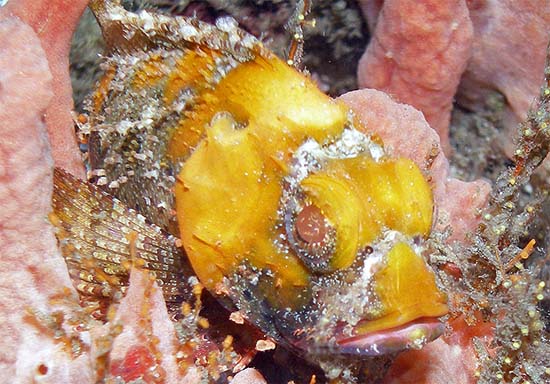
Dentition
The teeth of the barbfish are small, arranged in narrow bands on the jaws, palatine, and vomer.
Size, Age, and Growth
The maximum reported length of the barbfish is 13.8 inches (35.0 cm) total length (TL), however it is more commonly seen at lengths of approximately 7.9 inches (20.0 cm) TL.
Barbfish feed by camouflaging to blend into its surroundings and lying in wait until an unsuspecting prey items comes within reach. The barbfish then quickly opens its large mouth, creating a vacuum and instantly sucking in the prey. Prey items include crabs, shrimps, and bony fish.
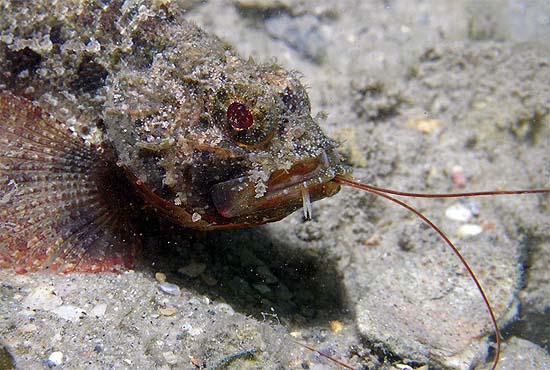
Reproduction
Scorpionfish are oviparous with females producing eggs that are transp
Predators
Larger marine fish are potential predators, however they have the venomous barbs to contend with when attempting to prey on the barbfish.
Parasites
Holobomolochus serratus, a parasitic copepod, has been documented in the gill chambers of the barbfish.
Taxonomy
The barbfish was originally described as Scorpaena brasiliensis by Cuvier in 1829. Synonyms referring to this species in past scientific literature include Scorpaena colesi Nichols 1914. The family Scorpaenidae, the scorpionfish, consists primarily of marine species and includes many of the world’s venomous fish. The common name barbfish refers to the ability in inject venom from spines in their fins.
Prepared by: Cathy Bester